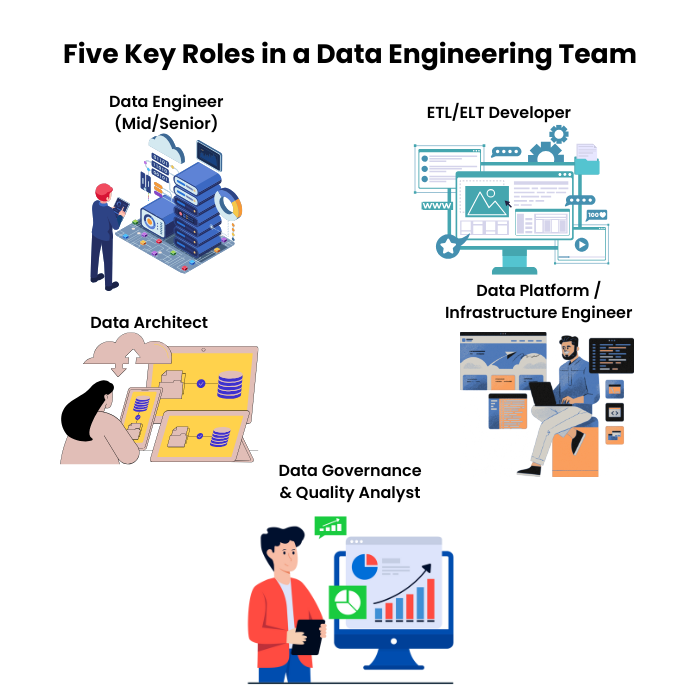A high-performing data engineering team doesn’t happen by luck. Behind every reliable pipeline and clean data flow is a structure—clear roles, the right balance of skills, and a setup that fits the business. But building that structure the right way? That’s where many teams struggle.
In this article, we’ll break down what an effective data engineering team structure looks like. You’ll learn the key roles, how they work together, and how to choose the right setup for your company’s size and goals. So read on—we’re going beyond job titles and digging into how to build a team that delivers.
What Does a Data Engineering Team Do?
A data engineering team builds the foundation that allows a company to use data reliably and at scale. They design, build, and maintain the pipelines that move raw data from different sources into usable formats—clean, organized, and ready for analysis. Without this layer, dashboards break, insights get delayed, and teams lose trust in the data.
Their job isn’t just moving data around. It’s about making sure data is accurate, up to date, and accessible when people need it. That means setting up systems that handle large volumes, managing storage, ensuring quality, and keeping everything running smoothly, whether it’s batch jobs overnight or real-time streams every second.
Now here comes the good part: a data engineering team is different from a data science or analytics team. While analysts and scientists focus on interpreting data and finding insights, engineers focus on building the systems that make that work possible. Think of it like this—if analysts are the drivers, data engineers build and maintain the road.
So read on—we’re about to dive into who exactly makes up this team and how they fit together.
Five Core Roles in a Data Engineering Team

A well-structured data engineering team is built around a few key roles. Each one plays a specific part in turning raw data into something the business can use. Let me explain the essentials:
Data Engineer (Mid/Senior)
This is the hands-on builder. Data engineers write the code that moves, cleans, and organizes data. They create and maintain pipelines, manage storage layers, and troubleshoot when things break. Senior engineers often take on more planning and system design while still staying close to the code. They’re the ones making sure data flows the way it should, day in and day out.
Data Architect
Think of this role as the blueprint creator. A data architect designs how all the systems fit together—from databases to data lakes to real-time streams. They decide how data should be stored, structured, and accessed. If engineers build the roads, architects decide where those roads go and how wide they need to be.
ETL/ELT Developer
This person specializes in how data is loaded and transformed. They set up the logic that extracts raw data, transforms it into something useful, and loads it where it belongs. Whether it’s batch or real-time, they make sure the steps happen in the right order with the right checks in place.
Data Platform / Infrastructure Engineer
Behind every fast, reliable pipeline is someone who ensures the platform can handle the load. This role focuses on cloud infrastructure, orchestration tools like Airflow, and monitoring systems that keep everything running. They’re the behind-the-scenes operators who ensure the engine stays on—even at scale.
Data Governance & Quality Analyst (if applicable)
In larger teams, someone often steps in to keep the data trustworthy. They define standards, run audits, and ensure that data is being handled properly, especially regarding privacy, security, and compliance.
How to Structure a Data Engineering Team
A solid team structure isn’t about how many engineers you hire—it’s about how you organize them to solve real business problems. A strong structure improves speed, reliability, and trust in your data. A weak one creates confusion, bottlenecks, and wasted effort.
Let me explain the most effective team models, when to use them, and what to watch out for.
Centralized Data Engineering Team
In a centralized model, all data engineers report to one manager and work as a single unit. They handle the entire company’s data pipelines, storage, tools, and documentation.
When it works well:
- Your company is small to mid-sized
- Most requests go through one data lead
- You need tight control over systems and standards
What to watch out for:
- The team becomes a bottleneck
- Engineers get pulled in too many directions
- Business teams feel disconnected from data decisions
Example: A startup with 3–5 engineers building company-wide pipelines and analytics support.
Decentralized (Embedded) Teams
Here, engineers are assigned directly to different business units—like product, finance, or marketing. Each team has its dedicated data engineer.
When it works well:
- The company is growing fast
- Different teams need unique data flows
- Speed and responsiveness are key
What to watch out for:
- Inconsistent tooling and standards
- Duplicate work across teams
- Harder to share knowledge and reuse solutions
Example: A mid-sized SaaS company embedding one engineer per product line for faster feature tracking and reporting.
Hub-and-Spoke Model
This hybrid approach keeps a central team to manage shared infrastructure and best practices (the hub) while embedding engineers in business teams (the spokes). It offers structure and speed.
When it works well:
- Your org is large enough to support multiple layers
- You want fast delivery without losing standardization
- There’s a budget for both platform and embedded roles
What to watch out for:
- Engineers in the spokes feel isolated
- Misalignment between central priorities and team needs
- More coordination required
Example: An enterprise company where the central team manages the data warehouse, while embedded engineers work on marketing attribution or product telemetry.
Cross-Functional Squads
Data engineers work in small, agile teams alongside data scientists, analysts, and product managers. Each squad owns a specific data product or function.
When it works well:
- You’re building user-facing data features
- Data drives your product roadmap
- You need fast iteration with minimal handoffs
What to watch out for:
- Engineers pulled into product work on the platform stability
- Redundancy in pipelines or tools
- Requires clear documentation and strong leadership
Example: A tech company building personalized recommendations or real-time features directly into the product.
How Does the Structure of a Modern Data Team Influence the Ideal Data Engineering Team Structure?
The structure of a modern data team influences the ideal data engineering team structure by enabling efficient collaboration and clear communication. A well-defined data team architecture allows engineers to focus on data quality and pipeline efficiency, ensuring that analytics teams receive timely and accurate insights to drive strategic decisions.
Choosing the Right Structure for Your Company
The right team structure isn’t about following a trend—it’s about supporting your business with the people and systems that make data useful. A good setup helps your team move faster, build smarter, and avoid doing the same work twice.
Let me explain how to think through the decision.
Start with Your Stage
A startup with one engineer has different needs than a company with five data teams. Early on, a centralized setup keeps things simple and controlled. As requests grow and departments get more specialized, consider moving to a hybrid or embedded model to keep up with demand.
Look at the Type of Work You Handle
Are your engineers mostly building internal pipelines? A central team makes sense. But if your marketing, product, or finance teams rely heavily on data to make daily decisions, embedded roles or cross-functional squads can speed things up.
Balance Specialists and Generalists
In small teams, you need generalists—people who can build pipelines, manage infrastructure, and fix bugs without asking for help. As your team grows, you’ll need specialists who can focus on specific tools, systems, or areas like quality or real-time processing.
Consider Cross-Team Collaboration
If your engineers rarely talk to analysts or product managers, you might need to rethink the structure. Good data work depends on shared context. Sometimes, embedding engineers or forming squads is less about speed and more about better communication.
Avoid Building a Team You Can’t Support
Every structure adds overhead. Don’t spin up squads if you don’t have enough engineers to support them. Don’t split into hubs and spokes if you don’t have someone strong leading the central team. Grow with purpose, not pressure.
Tips for Building and Managing the Team

Once you’ve got the structure right, the next challenge is making it work day to day. A good team on paper can still struggle without the right habits in place. So here comes the good part—five simple but effective tips to help your data engineering team stay productive and aligned.
1. Define Ownership Early
Make it clear who owns which pipelines, tools, and datasets. Without ownership, things fall through the cracks—or worse, get built twice. Good ownership doesn’t mean working in silos; it just means knowing who’s responsible for what.
2. Avoid Over-Engineering
It’s easy to chase the perfect setup, but most teams don’t need bleeding-edge tools right away. Focus on what solves today’s problems without locking you into tech debt tomorrow. Simple, well-documented systems beat fancy ones no one understands.
3. Hire for Curiosity, Not Just Skill
Data engineering tools change fast. Instead of just checking boxes for tech stacks, look for people who ask good questions, think in systems, and enjoy solving real-world problems. You can teach tools—you can’t teach mindset.
4. Keep the Feedback Loop Tight
Don’t let the data team disappear behind tickets and Slack threads. Create regular check-ins with analysts, PMs, or stakeholders. The closer the team stays to the users of the data, the better the output.
5. Invest in Internal Documentation
Write things down—even the small stuff. It saves time, reduces onboarding friction, and keeps your team from getting stuck when someone’s out. Treat docs like code: version them, update them, and keep them clean.
Conclusion
A strong data engineering team isn’t just a group of skilled developers—it’s a well-structured system built to support real business outcomes. The roles you hire, how you organize them, and how you manage day-to-day work all play a part in whether your data efforts succeed or stall.
Start simple. Choose a structure that fits your size and goals, then evolve it as your needs grow. Define clear roles, avoid unnecessary complexity, and keep your team connected to the people who use the data.
And remember—great teams aren’t built overnight. They’re shaped through small decisions made consistently over time.
So, whether you’re building your first data team or scaling one that’s already in motion, now you’ve got the blueprint.




